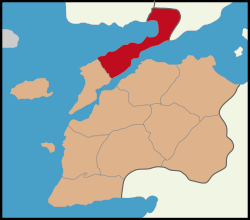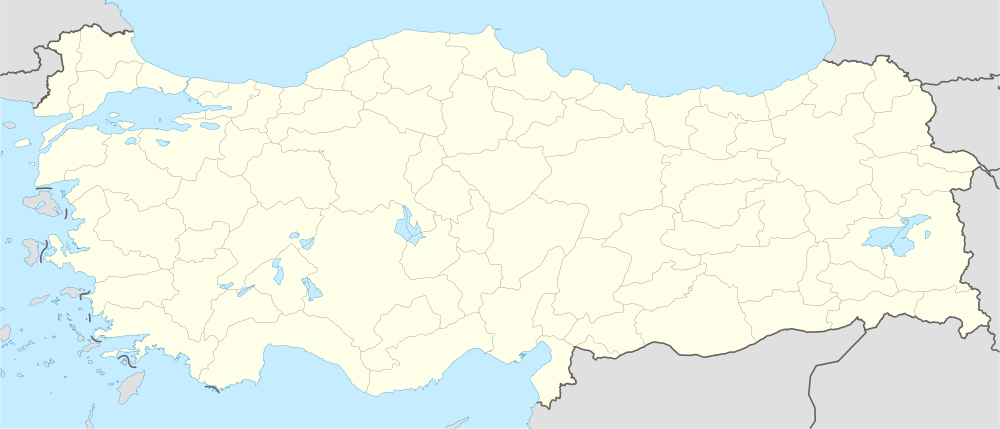Gelibolu
- For other uses, see Gallipoli (disambiguation).
| Gelibolu | |
|---|---|
| District | |
|
Gelibolu is a port on the Dardanelles. | |
 Location of Gelibolu within Çanakkale Province. | |
 Gelibolu Location of Gelibolu | |
| Coordinates: 40°24′N 26°40′E / 40.400°N 26.667°E | |
| Country |
|
| Region | Marmara |
| Province | Çanakkale |
| Government | |
| • Mayor | M. Mustafa Özacar (CHP) |
| • Governor | Namık Kemal Nazlı |
| Area[1] | |
| • District | 824.99 km2 (318.53 sq mi) |
| Elevation | 0 m (0 ft) |
| Population (2012)[2] | |
| • Urban | 29,998 |
| • District | 44,315 |
| • District density | 54/km2 (140/sq mi) |
| Time zone | EET (UTC+2) |
| • Summer (DST) | EEST (UTC+3) |
| Postal code | 17500 |
| Area code(s) | 286 |
| Licence plate | 17 |
| Website | www.gelibolu.bel.tr |
Gelibolu, also known as Gallipoli (from Greek: Καλλίπολις, kallipolis, "beautiful city"),[3] is the name of a town and a district in Çanakkale Province of the Marmara Region, located in Eastern Thrace in the European part of Turkey on the southern shore of the peninsula named after it on the Dardanelles strait, two miles away from Lapseki on the other shore.[4]
History

The Macedonian city of Callipolis was founded in the 5th century B.C.[4] It has a rich history as a naval base for various rulers. The emperor Justinian I fortified Gallipoli and established important military warehouses for corn and wine there, of which some Byzantine ruins can still be seen.[4][5] After the capture of Constantinople by the Latins in 1204, Gallipoli passed into the power of Venice. In 1294 the Genoese defeated a Venetian force in the neighbourhood. A body of Almogavars, under Roger de Flor, established themselves here in 1306, and after the death of their leader massacred almost all the citizens; they were vainly besieged by the allied troops of Venice and the Empire, and withdrew in 1307, after dismantling the fortifications.[4][5] After the city's defenses were damaged in earthquake, it was conquered by Turks in 1354 and became the first part of the Ottoman empire in Europe.[5] Bayezid I (1389–1403) built a castle and tower there which can still be seen.[4] In 1416 the Venetians under Pietro Loredan defeated the Turks here.[4] Gallipoli is the site of "tombs of the Thracian kings",[4] which refers to the graves of the Islamic writers Ahmed Bican (died 1466) and his brother Mehmed Bican (died 1451).
In 1854 the town was occupied by the allied French and British armies during the Crimean War who strengthened the defensive constructions from 1357.[4] Many soldiers died there of cholera and are buried in a local cemetery.[5] The guns of Gallipoli guarded the sea of Marmara until 1878 when more fortifications were built when the Russians threatened to take possession of Constantinople.[4] Gelibolu was the original center of Kaptanpaşa Eyalet; between 1864 and 1920 the town was the sanjak center in Edirne vilayet. In 1904 the Greek bishopric of Kallipolis was promoted to a metropolis and is listed under the Ecumenical Patriarchate of Constantinople.[5]The war at gallipoli was because England wanted to take over Turkey and sent groups of people to ask New Zealand and Australia for help. They both responded to help colonize Turkey. They helped because they felt it was their responsibility to help England.
The Bulgarian Army threatened Gelibolu during the First Balkan War and advanced to Bolayır in 1912. During the First World War the peninsula and the town were witness to a series of memorable battles (see Gallipoli Campaign). The town was occupied by Greeks between 1920–1922, and finally returned to Turkey in 1923 under the Treaty of Lausanne. Like the island Imbros off the western shore of the peninsula, Gallipoli had a majority of Greek inhabitants prior to WWI and thus was exempted in article 2 from the Convention Concerning the Exchange of Greek and Turkish Populations (1923). Between 1922 and 1926 the town was a provincial center and the districts of Gelibolu, Eceabat, Keşan (Enez became part of Keşan before 1953) and Şarköy.
Gelibolu today
Gelibolu is now an administrative center in the province of Çanakkale. The population of the district is 44,697 where 28,326 live in the center of the district (as of 2010) [6] The mayor is Münir Mustafa Özacar (CHP). Gelibolu is well known for sardine canning.
Notable people from Gelibolu
- Piri Reis (ca.1465-1555), a Turkish cartographer and geographer
- Ahmed Bican (? - ca. 1466), a Bayramiye dervish and Turkish writer
- Mustafa Âlî (1541–1600), a Turkish historian and bureaucrat
- Sofia Vembo (1910–1978), a Greek singer
References
- ↑ "Area of regions (including lakes), km²". Regional Statistics Database. Turkish Statistical Institute. 2002. Retrieved 2013-03-05.
- ↑ "Population of province/district centers and towns/villages by districts - 2012". Address Based Population Registration System (ABPRS) Database. Turkish Statistical Institute. Retrieved 2013-02-27.
- ↑ Καλλίπολις, Henry George Liddell, Robert Scott, A Greek-English Lexicon, at Perseus project
- ↑ 4.0 4.1 4.2 4.3 4.4 4.5 4.6 4.7 4.8 Gallipoli, Turkey in the 1911 Encyclopædia Britannica
- ↑ 5.0 5.1 5.2 5.3 5.4 Callipolis in the New Advent Encyclopedia
- ↑ Statistical Institute
